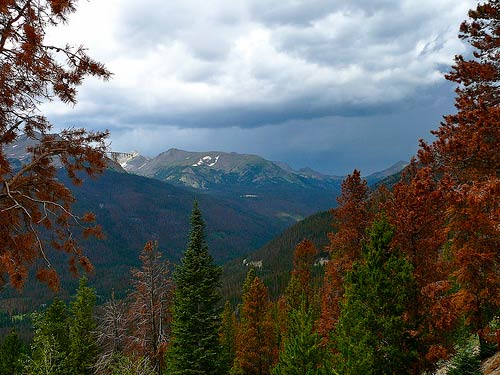
Once the numbers came in from the U.S. Forest Service’s annual aerial survey last month, people started to feel hopeful: The mountain pine beetle was declining in Colorado, Wyoming and South Dakota. In fact, the beetle infected fewer acres in Colorado in 2013 than in any year since 1998.
Through our Endangered Western Forests initiative, American Forests has been working to stem the tide of the mountain pine beetle. This native beetle has been causing as much damage in the past few decades as a runaway invasive. Cold Rocky Mountain winters that would normally help control their population have been getting warmer, allowing these pests to live longer, reproduce more and climb into higher elevations.
With the help of volunteers we’ve attached pheromone patches to healthy whitebark pine trees in the high-elevations of the Greater Yellowstone Area to repel these beetles. In 2013, we attached more than 400 patches to healthy trees in the Greater Yellowstone Area and we’ve got 10,000 more to go. (Email us to learn how you can get involved.)
We’re not the only ones working to protect our forests from these critters. Our partners, the Greater Yellowstone Coordinating Committee and the Whitebark Pine Ecosystem Foundation, along with many other organizations, researchers and caring members like you, have all been working nonstop to try to save these trees. So to see that these beetles are indeed in decline may seem like a reason to rejoice.
Not so fast. Restoration efforts aren’t the only cause of the beetles’ decline. Their own population boom is also coming back to bite them. There aren’t enough numbers of lodgepole, limber or ponderosa pines left to them to infest. In short, “they’ve kind of eaten themselves out of house and home,” Aaron Voos of the U.S. Forest Service tells Wyoming Public Media.
Here at American Forests, this news indicates that it’s more important than ever to protect the whitebark pine. With fewer of their normal fare left, the whitebark may become even more susceptible to these tiny menaces. And while any large-scale infestation can have widespread environmental consequences, the whitebark pine is a foundation species whose loss would have tremendous cascading effects in the ecosystem. For one thing, this high-elevation pine plays an important role in snowpack retention in the Rockies. Fewer whitebarks means earlier snowmelt and increased potential of flooding. Not the mention the consequences to fresh water supply for Rocky Mountain communities or to the skiing industry and its economic impact in the region.
We want to see the mountain pine beetle infestation slow. But that in itself is not necessarily an indicator of improved health in the ecosystem. We need to protect foundation species like the whitebark pine from this infestation, now more than ever.